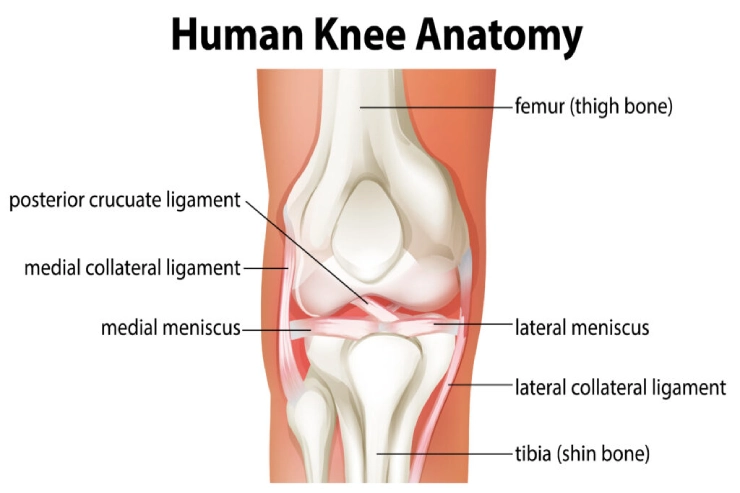
The largest joint in our body is the knee joint and one of the most easily injured joints. It is made up of bone, cartilage, tendons, and ligaments.
Bones:
- Femur (Thigh Bone)
- Tibia (Shin Bone)
- Patella (Kneecap)
The knee joint is formed by the convergence of three primary bones, each playing a crucial role in its structure and function.
Cartilage:
Articular Cartilage
Specialized cartilage covers the ends of the femur and tibia, along with the back surface of the patella. This articular cartilage facilitates smooth and frictionless movement during leg motion.
Meniscus:
Wedge-shaped Shock Absorbers
The menisci, positioned between the femur and tibia, act as shock absorbers. Their sturdy yet pliable nature stabilizes the knee joint and provides essential cushioning. In knee-related cartilage injuries, attention often centers on meniscal tears.
Ligaments:
Crucial Connectors
Several primary ligaments function as robust connectors within the knee joint, akin to strong ropes. These ligaments play a pivotal role in maintaining structural integrity and stability of the knee.

Conditions treated for Knee (Sports injury)
- ACL TEAR
- PCL TEAR
- RAMP INJURY
- MCL TEAR
- LCL INJURY
- MENISCUS TEAR
Osteoarthritis of the knee
Osteoarthritis of the knee occurs due to the deterioration of cartilage within the knee joint, leading to increased friction between bones and resulting in discomfort, stiffness, and swelling. Regrettably, this condition cannot be cured. However, there are treatment modalities available aimed at alleviating symptoms and impeding the progression of the condition.
Osteoarthritis of the Knee
Osteoarthritis in the knee is a degenerative joint condition characterized by the gradual breakdown of cartilage within the knee joint. This deterioration leads to increased friction between bones in the knee, resulting in pain, stiffness, swelling, and reduced mobility.
Prevalence
Statistics suggest that approximately 46% of individuals will experience knee osteoarthritis at some point during their lives. It is more prevalent among women, and the likelihood of its occurrence tends to increase with age, typically manifesting after the age of 40. However, certain factors such as injuries or genetic predispositions can cause it to develop earlier.
Symptoms
The most common symptom of knee osteoarthritis is persistent knee pain, especially during movement. Individuals may also experience discomfort while at rest. Stiffness in the knee, swelling, a feeling of instability or joint looseness, audible cracking or grinding sensations during movement, and occasional locking or buckling of the knee joint are other commonly reported symptoms.
Causes
Knee osteoarthritis is primarily caused by the gradual breakdown or damage to the knee joint’s cartilage. This erosion can occur due to various reasons, including wear and tear over time, injury, or specific genetic factors.
Diagnosis
Diagnosis involves a comprehensive examination by a healthcare provider, including a review of the individual’s medical history. Physical examinations assess joint inflammation, range of motion, stability, and gait abnormalities to identify indications of knee osteoarthritis.
Treatment Options
- Non-surgical treatments are often the initial approach and may include:
- Pain management with medications.
- Physical therapy to strengthen the knee and improve flexibility.
- Weight management to reduce stress on the knee joint.
- Using assistive devices like knee braces or orthotics.
- Injections such as cortisone or viscosupplementation.
- Surgical options might be considered in severe cases:
- Cartilage grafting to repair damaged cartilage.
- Knee osteotomy to realign the knee joint.
- Partial or total knee replacement surgery.
Prevention
While complete prevention may not be possible, certain measures can help reduce the risk of developing knee osteoarthritis, such as:
- Maintaining a healthy weight to decrease stress on the knee joint.
- Incorporating low-impact exercises like swimming or cycling into regular routines.
- Ensuring adequate rest and recovery after physical activities.
- Using proper techniques and caution during high-impact activities or sports to prevent knee injuries.
Consultation
Seeking advice and guidance from healthcare professionals is crucial for personalized management and treatment strategies suited to an individual’s specific condition and needs. Regular monitoring and adjustment of treatment plans may be necessary to manage knee osteoarthritis effectively.

